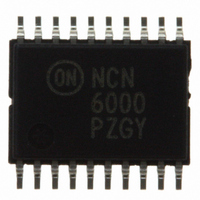NCN6000DTBR2 ON Semiconductor, NCN6000DTBR2 Datasheet - Page 23

NCN6000DTBR2
Manufacturer Part Number
NCN6000DTBR2
Description
IC INTERFACE SMART CARD 20TSSOP
Manufacturer
ON Semiconductor
Datasheet
1.NCN6000DTBR2.pdf
(36 pages)
Specifications of NCN6000DTBR2
Applications
ATM Terminals, Gas Pumps, ISM
Interface
Microcontroller
Voltage - Supply
2.7 V ~ 6 V
Package / Case
20-TSSOP
Mounting Type
Surface Mount
Lead Free Status / RoHS Status
Contains lead / RoHS non-compliant
Other names
NCN6000DTBR2OSTR
Available stocks
Company
Part Number
Manufacturer
Quantity
Price
Part Number:
NCN6000DTBR2
Manufacturer:
ON/安森美
Quantity:
20 000
Part Number:
NCN6000DTBR2G
Manufacturer:
ON/安森美
Quantity:
20 000
programmed CRD_VCC, the system operates under the
boost mode, providing the voltage regulation and current
limit to the smart card. In this mode, the external inductor,
typically 22 mH, stores the energy to drive the +5.0 V card
supply from the external low voltage battery. The
programmed CRD_VCC, the system operates under a step
down mode, yielding the voltage regulation and current
limit identical to the boost mode. In this case, the built−in
structure turns Off Q1 and inverts the Q2 substrate bias to
control the current flowing to the load.These operations are
fully automatic and transparent for the end user.
external inductor L1 are sensed by the operational amplifier
U1 associated with the internal shunt R1. Since this shunt
resistor is located on the hot side of the inductor, the device
reads both the charge and discharge of the inductor,
providing a clean operation of the converter.
efficiency, it is recommended to use external inductor with
R < 2.0 W.
converter and smooths the CRD_VCC voltage applied to the
external card. At this point, care must be observed, beside the
micro farad value, to select the right type of capacitor.
According to the capacitor’s manufacturers, the internal ESR
can range from a low 10 mW to more than 3.0 W, thus yielding
high losses during the DC−DC operation, depending upon the
technology used to build the capacitor.
When the input voltage Vbat is lower than the
When the input voltage Vbat is higher than the
The High and Low limits of the current flowing into the
In order to optimize the DC−DC power conversion
The output capacitor C1 stores the energy coming from the
Figure 18. DC−DC Operating Modes
Ibat
POWER_ON
CRD_VCC
I
L
Step Down Mode
CRD_VCC 5 V Step Up Mode
http://onsemi.com
NCN6000
23
oscillogram, Figure 18, depicts the DC−DC behavior under
these two modes of operation.
impedance to ground during the Power Down sequence,
yielding the 250 ms maximum switch time depicted in the
data sheet.
advantage for a relative high micro farad value, but have
poor tolerance, high leakage current and high ESR.
together with high capacity value per volume, but cost can
be an issue and ESR is rarely better than 500 mW.
with ESR in the 50 mW range, but value above 10 mF are
relatively rare. Moreover, depending upon the low cost
ceramic material used to build these capacitors, the thermal
coefficient can be very bad, as depicted in Figure 20. The
X7R type is highly recommended to achieve low voltage
ripple.
100%
8
7
6
5
4
3
2
1
0
15%
Beside the DC−DC converter, NMOS Q4 provides a low
The standard electrolytic capacitors have the low cost
The tantalum type brings much lower leakage current
The new ceramic type have a very low leakage together
2.5
Figure 20. Typical Y7R Ceramic Type Value as a
Figure 19. Typical DC Operating Current
−25°C
3.0
DC Operating Current @ CRD_VCC = 5.0 V
Function of the Temperature.
3.5
4.0
Vbat (V)
+25°C
4.5
−25°C
5.0
5.5
+85°C
25°C
85°C
6.0











